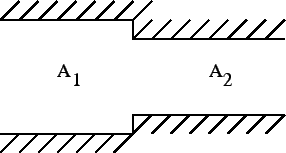 |
A sudden contraction (Figure 116) is characterized by head
losses
![]() of the form:
of the form:
 |
(130) |
where ![]() is a head loss coefficient depending on the ratio
is a head loss coefficient depending on the ratio ![]() ,
,
![]() is the mass flow, g is the gravity acceleration and
is the mass flow, g is the gravity acceleration and ![]() is the
liquid density.
is the
liquid density. ![]() and
and ![]() are the larger and smaller cross section,
respectively. Notice that this formula is only valid for
are the larger and smaller cross section,
respectively. Notice that this formula is only valid for
![]() . For
a reverse mass flow, the formulas for a pipe enlargement have to be taken. Values for
. For
a reverse mass flow, the formulas for a pipe enlargement have to be taken. Values for ![]() can be found in file ``liquidpipe.f''.
can be found in file ``liquidpipe.f''.
The following constants have to be specified on the line beneath the *FLUID SECTION, TYPE=PIPE CONTRACTION card:
The gravity acceleration must be specified by a gravity type
*DLOAD card defined for the elements at stake. The material
characteristic ![]() can be defined by a
*DENSITY
card.
can be defined by a
*DENSITY
card.
Example files: centheat1, pipe.